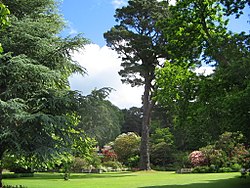Bodnant Garden
| Bodnant Garden | |
|
National Trust | |
|---|---|
 Bodnant Garden | |
| Grid reference: | SH801723 |
| Information | |
Bodnant Garden is a beauteous garden estate in Denbighshire, lying by the east bank of the River Conwy. It is owned and managed by the National Trust and opened to visitors. The garden is found near Tal-y-Cafn.
The garden overlooks the Conwy valley and the river and beyond to the Carneddau range of mountains in Snowdonia.
History
This important garden occupies 80 acres surrounding Bodnant House, most of which was first laid out by Henry Davis Pochin, a successful industrial chemist, from 1874 onwards until his death in 1895. Bodnant House had been built in 1792 but was remodelled by Pochin and on his death it was inherited by his daughter (whose husband became the first Baron Aberconway in 1911). The garden, but not the House or other parts of the estate, was presented to the National Trust, with an endowment, in 1949. The House was the home of the late Lord Aberconway, and members of his family continue to be actively involved in the management of the garden, its tea pavilion and car parks on behalf of the National Trust.
Attractions
The gardens are varied and include formal gardens bounded by clipped box hedges, ornamental ponds and pools and formal herbaceous borders, an enclosed laburnum arch and many rose gardens. However, Bodnant is most famous for its breeding programme, especially of varieties of Rhododendrons and azaleas examples of which are now grown throughout the world. Also noted are the collections of Magnolia, Camellia, Clematis and Hydrangea.
The Pin Mill, originally built as a gazebo at Woodchester Mansion, Gloucestershire in 1730, was later used as a pin mill. It was moved to Bodnant Garden in the 1930s and re-erected on the canal terrace in the gardens.
Origins
Begun in 1875, it is the creation of four generations of Aberconways and is divided into two parts: the upper level (around the house) features huge Italianate terraces, specimen trees and formal lawns, with paths descending to at lower level "The Dell" with a wooded valley, stream and wild garden below. Included within the Dell are the Old Mill, the mill pond with the mill race and an attractive spillway waterfall into the River Hiraethlyn, to give the delightful babbling brook through the Dell its proper name.
Of the many specimen trees within the Dell and the Woodland, notable are several Californian Redwoods. One giant redwood (sequoiadendron giganteum) measured 155 feet in height.[1] Another tree from the western United States, the Oregon Douglas Fir Pseudotsuga menziesii was 157.5 feet (48.0 m).[2] From China about 1949 came the Dawn Redwood, previously known only from fossils and believed to have been extinct.[3]
Above the Dell is "The Poem", the family mausoleum from which a network of paths leads through shrubberies and the Rosemary garden to the front lawn (separated from the old park by a ha-ha) and across the lawn to the Round garden.
Outside links
| ("Wikimedia Commons" has material about Bodnant Garden) |
- Bodnant Garden information at the National Trust
- Bodnant entry from The DiCamillo Companion to British & Irish Country Houses
- Bodnant Garden Illustrated Guide to Snowdonia
- Bodnant Garden Great British Heritage Pass
- Pictures of Bodnant Garden and the area on Geograph.co.uk
References
- ↑ "Tal-y-Cafn - Bodnant Gardens". web page. Redwood World. http://www.redwoodworld.co.uk/picturepages/talycafn.htm. Retrieved 20 April 2012.
- ↑ "Wondermondo Wales". web page. Gatis Pāvils. http://www.wondermondo.com/Wales.htm. Retrieved 20 April 2012.
- ↑ "Monumental Trees The Dawn Redwood". web page. MonumentalTrees.com. http://www.monumentaltrees.com/en/trees/dawnredwood/dawnredwood/. Retrieved 20 April 2012.
- The Garden at Bodnant Jarrold Publishing Norwich and Bodnant Garden, 2001.


